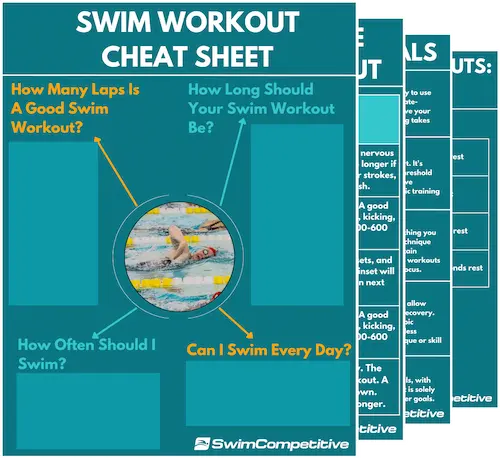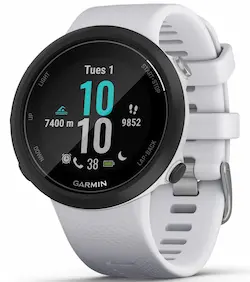Warmup and cooldown are two essential components of a swimmer’s routine. Whether you’re a beginner or a seasoned professional, incorporating a swimming warm-up and cool-down is critical for optimal performance, preventing injuries, and optimizing recovery.
A proper warm-up will prepare your body to perform optimally during your training session or race.
Similarly, a good cool-down routine helps you recover faster, relax your nervous system, and prepare for your next race or training session.
In this article, I will discuss the importance of warming up and cooling down for swimming. I will explain why you need to incorporate these techniques and how to do so correctly and effectively.
The Benefits of Doing a Swimming Warm Up
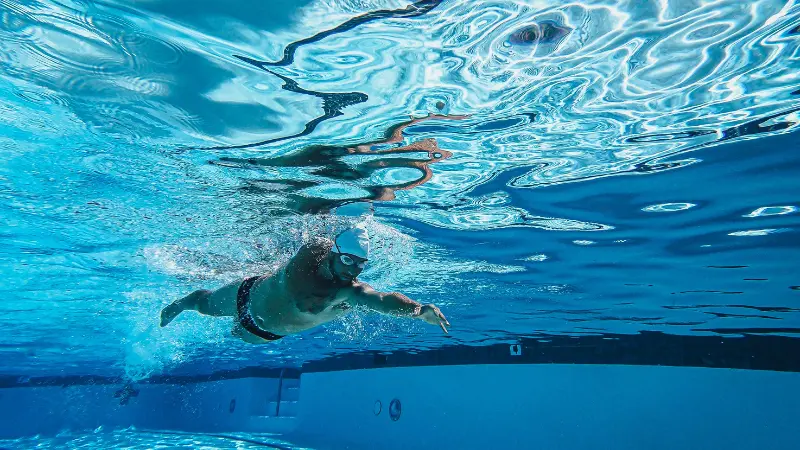
Reduces Your Risk of Injury and Boosts Swimming Performance
Warming up before swimming, whether for a training session or competition, is essential for preventing injuries and increasing performance.
Here are a few ways a warmup helps with this:
- Increasing blood flow: Warming up increases blood flow to the muscles and constricts blood to other body parts that are not as important (think: your stomach).
- Improved flexibility: The increase in blood flow and body temperature will help muscles stretch to their optimal length, creating proper tension and mobility throughout the body.
- Increased body temperature: An increased body temperature means increased metabolic activity. This means all the substrates and enzymes that help create energy in your body are working faster and more efficiently, helping you perform optimally in the water.
- Mental preparation: Mental preparation can lead to a calm but alert state during competition and boost focus and presence during training.
Helps To Get You In The Zone
Warming up before swimming can help you mentally prepare for your main set while training or your race in competition by sharpening your focus, improving your confidence, and reducing anxiety.
By preparing your mind and body for the swim, you can perform at your best and achieve your goals in the water.
During the dryland warmup and before, it is a great time to incorporate breathing and focus into the routine.
Spend 2-5 minutes laying still and breathing.
You can use something like the box breathing technique.
To do this, breathe in for 5 seconds, hold for 5 seconds, breathe out for 5 seconds, and hold again for 5 seconds before repeating.
The box breathing technique (the 5-5-5-5) helps center the breath, center your focus, and control your emotional energy.
Related: Breathing exercises for swimmers.
Good Time to Work on Swimming Technique and Skills
In addition to the physiological and psychological benefits of warmups, this is a great time to practice your swimming skills and drills.
If you are at a competition, then focusing on some drills and proper technique is great to incorporate into warmup.
We aren’t trying to learn anything new so to speak but familiarize ourselves with proper stroke mechanics. Practicing familiar drills and stroke techniques will help accelerate this process and ensure you swim fast and skillfully.
If you are training, practice some skills that get progressively more challenging. This is an excellent time to let your body figure out its position in the pool before you are fatigued.
The Benefits of a Cool Down for Swimming
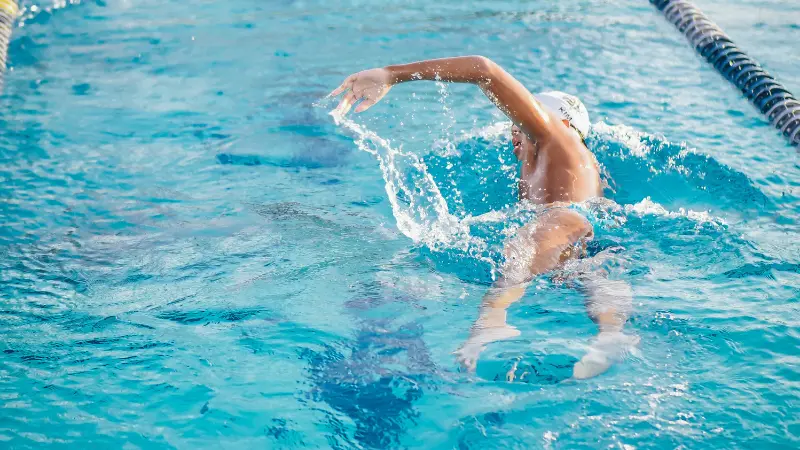
Speeds Up Recovery and Helps Your Mind to Reset and Relax
Cooling down after swimming can speed up recovery by reducing muscle soreness and fatigue, preventing injury, and promoting circulation.
While swimming, your muscles generate heat, and cooling down helps to dissipate this heat, preventing the accumulation of waste products such as lactic acid.
A gradual decrease in exercise intensity during the cool-down period allows the body to gradually return to its resting state, reducing the risk of injury and promoting recovery.
This can also help us mentally relax, adapt to a greater degree and reset for our next practice or race!
Furthermore, cooling down after swimming promotes circulation, which removes waste products and delivers oxygen and nutrients to the muscles. This can help reduce muscle soreness and fatigue and improve recovery.
Additionally, cooling down after swimming can help lower your heart rate and blood pressure, reducing nausea and feelings of dizziness that may occur.
Cooldown Improves Flexibility
Swimming is a low-impact exercise that can be performed for extended periods, resulting in muscle fatigue, tightness, and inflammation.
Additional, stretching or foam rolling as part of your cooldown can help you relax and improve your flexibility.
Static stretching after swimming elongates the muscles and reduces tension, which prevents injury, increases flexibility, and improves overall performance.
Foam rolling is another effective way to release muscle tension and tightness, especially in the large muscle groups used in swimming, such as the shoulders, back, and legs.
Foam rolling can also help increase blood flow and reduce inflammation, speeding up the recovery process and promoting full range of motion.
How Long and Intense Should a Swimming Warmup and CoolDown Be?
The length of your swimming warmup and cooldown will vary depending on your fitness level and the workout’s intensity.
During the warmup, it’s important to gradually increase your heart rate and loosen up your muscles before beginning the main part of the workout. This can include some light swimming, dynamic stretching, and drills.
According to Sports Med Open, swimmers can optimize their performance from a warmup that includes roughly 1000m of swimming, performed at an intensity of ≤ 60% of maximum oxygen consumption.
In other words a moderate effort is the most beneficial pace to swim at. Especially if this is followed by roughly 5 minutes of dryland activity, leaving no more than 15 minutes of rest during the transition phase between the two. This keeps muscle activity and body temperature elevated until your main set or race.
Off course, for a normal training session, you’ll do your dryland warmup beforehand as you aren’t going to get out of the pool again as you would at a meet.
During the cool down, the focus is reducing your heart rate while moving at a moderate pace. This can include some slow swimming, easy drills, and static stretching exercises.
To conceptualize this, keep swimming intensity and duration constant and moderate during cooldown and follow it with some easy stretching, foam rolling, etc. According to the International Journal of Sports Physiology and Performance five minutes of active recovery followed by 10 minutes of passive recovery was the most effective outcome for repeated performance.
It’s essential to listen to your body and adjust the length of your warmup and cooldown accordingly.
If you’re feeling particularly stiff or sore, you may need to spend more time warming up or cooling down.
Dryland Warm Up for Swimming: Exercises and Stretches
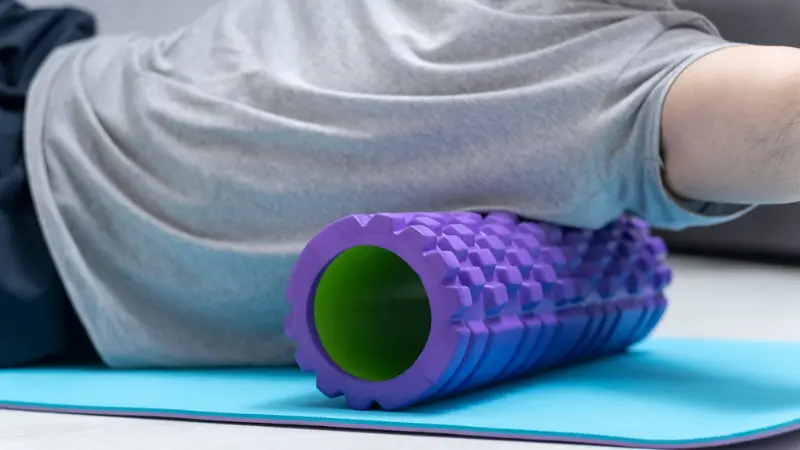
A dryland warm-up is encouraged amongst swimmers but optional.
Personally, I like to partake in light stretching and some dynamic warm-up before I get in the pool. This helps me feel more energized by promoting blood flow to the muscles.
That said, for swim meets you’ll have the option of doing your dryland warm-up either before or after your pool warm-up. It’s up to you to decide what works best for you.
When designing your dryland warm-up, don’t overcomplicate it.
A good rule of thumb is to have a set number of exercises to do everyday or every other day before you get in the water for swim practice to prepare for your in-water warm-up.
Personalize this to what makes you feel best, most often in training.
Pro Tip: Think about a dryland warmup. Its purpose is to prepare you for the best possible swim practice you can have. Remember this if you get lost in the weeds of creating your dryland warmup.
The principle of any warmup is to go from general to specific. This is a gradual ramp-up process to open up the body, increase body temperature, and activate specific muscles and antagonist muscles that will be used in the pool.
Step 1: Increase Body Temperature
First, we want to increase body temperature gradually. You’ll do a lot of this once you hop in the water, so it’s a good idea to keep it light. Here is a short list, and feel free to add ideas that come to your mind.
- Jump rope is excellent and helps create some ankle stability and proprioception that will be beneficial for starts and turns.
- A light jog
- Skips (backward, forwards, side to side)
Step 2: Open Up The Body to Increase Mobility and Range of Motion
Secondly, we will open up the body with a combination of myofascial release, dynamic stretches, and breathing.
Unless a Physiotherapist has instructed you, stay away from hard lacrosse balls. It’s better to save the more intense mobility work for after practice.
Also, be careful not to foam roll “too hard,” and this might be counterintuitive to the warmup process.
- Lightly Foam roll the Lat, Serratus Anterior, and shoulders
- Lightly foam roll the Quads and Hamstrings
- Light Yoga Poses Oscillations
- Butt Kicks
- Leg Swings
- Some deep breaths with the band
Step 3: Activation
The third step is general activation. This will mainly include the core and some light movement that will turn on the nervous system and help increase body awareness. A band or two is also a handy way to warm up. For example:
- HIP 90/90 x 5 each
- Squat Hold against a wall for 30 seconds
- Banded Glute Bridge
- Banded Plank Rows
- Hollow Rocks
- Banded Side Plank Rows
- Shoulder Taps in Front Plank
- Side Plank Rotations
Note: use one instead of both plank exercises (the non-banded examples can be alternatives or something different if you prefer.)
The last step of the warmup process is specific activation. Activate the specific muscle groups involved in swimming.
Focus first on the lower body, then the shoulders. Make sure you are breathing well the entire time and keeping tension in the glutes, back, and abs (otherwise known as your core!).
Pro Tip: A cheat for setting up bands is to tie a band (the same way you would tie a bag tag around your swim bag!) around the flag (the pole, not the actual flag) and then wrap another band around that one without tying it. Boom! You have yourself a nice setup!
- Banded Rows
- Banded A’s, T’s, Y’s
- Shoulder 90/90s
- Banded Lat Pulldown
- Bear Hugs
- Banded Walks
- Med Ball Slams
- Banded Hip Flexion
- Banded Paloff Press
- Banded Rotational Punch
OR (some alternatives)
- Bent-over DB Rows
- Bent-over DB T’s
- Bent-over DB A’s
- Scap Push-ups
- Hip Series
- Lie on your side, and raise your leg in the air (abduction). Do ten slow reps. Cross the same leg over your body and raise the opposite leg in the air (adduction). Do another ten reps. Repeat for the other side!
Note: One set is preferred for all of these. Go from here. You’ll probably never need to change what you’re doing, but mixing exercises every other day is advisable. Once you get in a routine, this will be quick, 10-15 minutes max!
Pro Tip: Try to get in the habit of getting to practice 15 minutes early and do this extra work. This will have you jumping in the water prepped and ready to perform.
For some more dryland warmup exercises, refer to these videos.
The first video explains some static warm up exercises (meaning you can do them in the same place, the exercises themselves still involve movement though, making them dynamic):
The second explains some locomotive warm up exercises (meaning they require more space for movement):
Swimming Warmup Sets: Structure and Examples
Structuring a swim competition or training warmup is critical for ensuring swimmers perform at their maximum potential. Here’s a general outline of how to structure a swimming competition warmup:
Dryland warmup
Swimmers should start with a 10-15 minute dryland warmup (like the one listed above). This will help to increase heart rate and blood flow and activate the muscles.
Water warmup
The in-pool warmup will follow a similar outline as the dryland since it moves from general preparation to specific preparation.
Swimmers should gradually increase the intensity of their swim, focusing on technique and steady breathing.
They should also simulate the conditions of the upcoming race, such as the number of strokes per lap, turns, starts, etc.
Speed work
After the initial warmup, swimmers should perform some short, high-intensity swims, such as sprints or fast-paced intervals, to increase heart rate and get their muscles ready for the main event.
Recovery
After the speed and/or pace work, swimmers should do some easy swimming or kicking to help them reduce any fatigue from the warmup. This will help you feel fresh and energized for your race or training session.
Mental preparation
Swimmers should use the warmup period to mentally prepare themselves for the task at hand.
This can include visualization techniques, positive self-talk, and focusing on their goals and strategies for the day.
Using visualization techniques every day for short periods of time can be beneficial for performance. This is the mental preparation side of swimming.
When visualizing, you can see yourself in the first or third person when swimming your race and use as many senses as possible (sight, smell, feel, sound etc.).
Swimming Warm Up Set 1: Training Warm Up Example
Generally, warming up for a training session is much simpler than warming up for a swim meet.
Dryland: 10-15 minutes of dynamic warm up/ stretching
Warmup set:
- 200 swim
- 200 kick
- 200 pull
- 200 drill
Warmup Activation:
- 6x25s: 15m sprint, 10m easy on 0:45
Swimming Warm Up Set 2: Training Warm Up Example
Dryland: 10-15 minutes of dynamic warm up/ stretching
Warmup set:
- 800 easy swim w/ snorkel and paddles
Activation:
- 6x50s on 1:00 (15 sprint, 10m scull, 25m easy distance per stroke swimming)
Swimming Warm Up Set 3: Competition Warm up Example:
Dryland:
- 10-15 minutes of dynamic warm up/stretching
Warm Up
- 300 swim
- 2x100s kick negative split
- 200 pull, 75 swim/25 scull
- 200 IM (25 drill/25 swim)
Heart Rate Work
- 10x50s on 0:50
- Odds: descend 1-5
- Evens: easy
Speed Work
- 8x25s variable speed on 0:30 (emphasis on breakouts and finishes)
- 1 – ½ fast, ½ easy
- 1 – ½ easy, ½ fast
- 1 – all easy
- 1 – all fast
- Repeat x 2
Pace/starts if needed
- Mid distance/distance: 50’s pace to help stimulate your race.
- 1-2 starts practicing water entry and breakout.
It’s essential to note that warm up routines will depend on the individual and the meet format. Coaches can give you feedback to help develop a warmup routine that works for you!
How to Cool Down for Swimming
Cooling down after swimming is just as important as warming up before.
It helps to decrease heart rate, and body temperature, promote a parasympathetic (relaxed) state, and clear metabolic byproducts.
It’s essential to listen to your body and adjust your cooldown accordingly.
The amount of cool down you need after an intense swimming session will depend on the duration and intensity of your workout, as well as your fitness level.
Aim to spend at least 10-15 minutes cooling down after an intense swim or race. Ensuring you’re doing enough cool down is vital for maximum recovery.
Pro Tip: Taking your heart rate after your cooldown can be a helpful tool to tell you if you need to keep going. I usually make sure my heart rate is 100-110 bpm before stopping!
Using tools like a swim watch or a chest-strap waterproof heart rate monitor is an accurate way to take your heart rate.
Cooldown Sets for Swimming
Cooldown isn’t complicated and mostly consists of easy swimming. Make sure to mix up your strokes (I recommend doing a lot of backstroke if you can). You can also do some light kicking with a kickboard to loosen up your legs.
- Set 1: 800 easy swimming alternating backstroke and freestyle by 100
- Set 2: 16x50s easy swimming with fins on 1:00
- Set 3: 400 easy swim, 200 kick with a board
Tips and Considerations for Swim Meets
- Stay warm after the initial warmup. Clothes, shoes, AND gloves.
- Consider re-familiarizing yourself with the pool for 5-10 minutes, 20 minutes before your race.
- If you have another race, consider getting back in the pool! Ten minutes of swimming at a moderate effort is the minimum to clear lactate before your next race.
- If there is no warm up pool, stay moving! (a light walk and light foam rolling after may be a great option)
Warm Up and Cool Down Properly To Maximize Swimming Performance
Warm Ups and Cooldowns are a centerpiece of great swimming. To maximize performance, recovery, and longevity in the sport of swimming, these things are non-negotiables.
Warmup will allow you to perform better, swim faster, and recover more quickly.
Cooldowns will ensure a healthy body and mind, faster recovery, and quicker adaptations to training or competition.
Incorporate these techniques into your daily practice and refine them every day.
Use these tools as an outline for yourself, and as the quote from Bruce Lee says, “Absorb what is useful, discard what is useless, and add specifically what is your own.”
